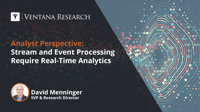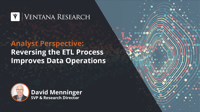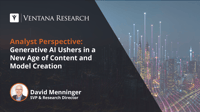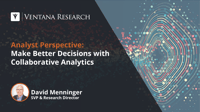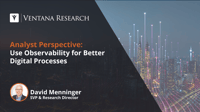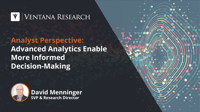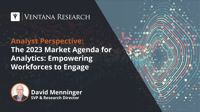In my past perspectives, I’ve written about the evolution from data at rest to data in motion and the fact that you can’t rely on dashboards for real-time analytics. Organizations are becoming more and more event-driven and operating based on streaming data. As well, analytics are becoming more and more intertwined with operations. More than one-fifth of organizations (22%) describe their analytics workloads as real time in our Data and Analytics Benchmark Research and nearly half (47%) of...
Read More
Topics:
Analytics,
Business Intelligence,
Data,
Digital Technology,
Streaming Analytics,
Analytics & Data,
Streaming Data & Events
At one point, analytics and business intelligence were considered non-mission critical activities. One of the primary concerns in designing analytics systems was to ensure they didn’t interfere with or draw computing resources away from operational systems. But today, analytical systems are integral to many aspects of operations. More than 9 in 10 participants in our Analytics and Data Benchmark Research reported analytics had improved activities and processes. However, most analytics and BI...
Read More
Topics:
Analytics,
Business Intelligence,
Data Management,
Data,
Digital Technology,
data operations,
Analytics & Data
If I had a magic wand, I would want to add scenario evaluation to all business intelligence tools on the market. I have previously written about the need to make intelligent decisions with decision intelligence. The data and analytics markets have evolved so that organizations have far greater capabilities to utilize data in decision-making processes. While there is some convergence around the concept of decision intelligence, there are still several “islands” of decision-making. Analyzing...
Read More
Topics:
business intelligence,
Analytics,
Business Planning,
Digital Technology,
Analytics & Data
MicroStrategy is a long-standing business intelligence and analytics vendor that operates worldwide. Founded in 1989, this publicly traded company with hundreds of millions of dollars in revenue recently held its first in-person conference since prior to the pandemic. Similar to previous in-person events, the event was well attended by about 2,000 attendees and exhibitors. The theme, “MicroStrategy ONE,” is a way to explain the breadth of capabilities the company offers. The breadth of the...
Read More
Topics:
embedded analytics,
Analytics,
Business Intelligence,
Digital Technology,
natural language processing,
Analytics & Data
Artificial intelligence (AI) has evolved from a highly specialized niche technology to a worldwide phenomenon. Nearly 9 in 10 organizations use or plan to adopt AI technology. Several factors have contributed to this evolution. First, the amount of data they can collect and store has increased dramatically while the cost of analyzing these large amounts of data has decreased dramatically. Data-driven organizations need to process data in real time which requires AI. In addition, analytics...
Read More
Topics:
Analytics,
Digital Technology,
natural language processing,
AI & Machine Learning,
Analytics & Data
Generative AI is a class of artificial intelligence used to generate new, seemingly real content. Broadly speaking, AI has traditionally been used to identify patterns in data and apply those patterns to categorize and predict behaviors. For instance, it can organize customers into groups (or clusters) with similar characteristics, or predict which customers are most likely to respond to certain offers.
Read More
Topics:
Analytics,
Digital Technology,
AI & Machine Learning
In my perspective on decision intelligence, I lamented the fact that business intelligence technologies have left the rest of the exercise to the reader for too long. Making a decision is a process that involves many steps and many people. Decision-making is so complicated and divorced from day-to-day business processes that organizations have had to create entirely separate teams to focus on the analytics and data to support it. One aspect of the decision-making process that can be enhanced by...
Read More
Topics:
Analytics,
Business Intelligence,
Digital Technology,
Analytics & Data,
Collaborative & Conversational Computing
For years various types of systems have produced log files to help with monitoring, debugging and performance management. Often, this information was used in forensic analyses of why interruptions in service or other problems occurred. In many cases, log files are still used this way. But systems have grown more complicated, and many more devices are instrumented. Systems have been decomposed into much finer-grained, interdependent services. Infrastructure is now distributed between on-premises...
Read More
Topics:
Business Continuity,
Digital Technology
I’ve previously written about the analytics continuum, which spans a range of capabilities including reporting, visualization, planning, real-time processes, natural language processing, artificial intelligence and machine learning. I’ve also written about the analysis that goes into making intelligent decisions with decision intelligence. In this perspective, I’d like to focus on one end of the analytics continuum, which I’ll label advanced analytics.
Read More
Topics:
Analytics,
Digital Technology,
AI & Machine Learning,
Analytics & Data
Ventana Research recently announced its 2023 Market Agenda for Analytics, continuing the guidance we have offered for nearly two decades to help organizations derive optimal value from technology investments to improve business outcomes.
Read More
Topics:
embedded analytics,
Analytics,
Business Intelligence,
Data,
Digital Technology,
natural language processing,
Process Mining,
Analytics & Data,
Collaborative & Conversational Computing
